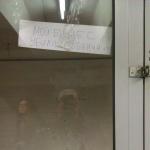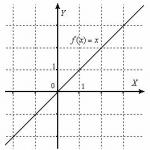Lathe malfunctions and their elimination. Lead screw and lead shaft. The main causes of malfunctions of CNC machines
A very important issue for maintaining the normal quality of operation of CNC machines is the choice of the most rational method of troubleshooting.
In practice, three search methods are mainly used.
1. Boolean method is based on knowledge of the composition and operation of the equipment, analysis of the output of actual information and its comparison with a given control program, knowledge of the procedure for processing information on the nodes and blocks of the device, correct definition characteristic and uncharacteristic errors in control program and malfunctions in CNC devices on the machine itself. Based on the analysis of the action of the input information and the results of the output information, a logical conclusion is made about existing defects and ways to eliminate them to ensure normal operation CNC machine.
2. The practical method of troubleshooting is carried out using special measuring instruments. In this case, the defective chain is divided into two parts. Then the part in which the fault is detected is divided again. And so on - until a faulty board is found that needs to be replaced. After this, a general check of the device is carried out and a conclusion is drawn about the quality of operation of the CNC system and the machine as a whole.
3. The test method for troubleshooting CNC machines is used in a workshop environment. In this case, the operation of the CNC device as a whole or its individual components, which perform completed micro-operations, is checked by influencing them with appropriate test programs. The test method allows you to relatively quickly identify a defect and take the necessary measures to eliminate it.
Malfunctions of the input unit with a photo-reading device, as well as the linear interpolator and speed setting unit are the most typical for the CNC systems used on modern metal cutting machines. The causes of malfunctions of the input unit are most often the aging of photodiodes or contamination of the optics of the photo-reading device and the tape drive mechanism.
To prepare and control control programs at factories and associations where CNC machines operate, specialized areas equipped with the necessary equipment have been created.
When using CNC machines, increased requirements are also placed on the electrical equipment installed on them. It must provide the ability to promptly eliminate interference in places where it occurs, and also have the ability to reliably control high-current equipment and electric motors by means of weak signals or contacts.
CNC machines, unlike conventional machines, are equipped with a separate feed drive for each controlled movement coordinate, which operates from control system and must provide high accuracy positioning and sufficient speed. For this purpose, high-speed drive motors are used - hydraulic, electro-hydraulic (stepping or servo) and electric. Structural and technological methods ensure maximum elimination of the gap in the kinematic chain (for example, by replacing conventional screw gears with ball screw pairs) and reduce friction in the guides to a minimum, selecting optimal masses of moving units, etc.
Particular attention should be paid to maintaining the hydraulic drive. The type of oil to be filled into the hydraulic system must comply with the requirements of the operating manual for this equipment. The oil must be clean, filtered and homogeneous (it is not recommended to mix different brands of oils). Violation of the tightness of the hydraulic system, leakage and reduction of the permissible oil level must not be allowed. Before starting the machine, it is necessary to turn on the hydraulic system for a while to warm up the oil.
According to the current situation, all measures for preventive repair of equipment and equipment, as well as other types of maintenance of CNC machines, must be carried out only by specially trained personnel who have the appropriate permit, and the machine operator is prohibited from independently performing any operations on the machine that are not part of his duties. However, the operator must not only know when and what activities are provided for in the maintenance schedules of the CNC machine on which he works, but also systematically monitor their implementation in accordance with the established schedules, and also, if necessary, directly participate in them, providing every possible assistance. assistance and assistance to maintenance personnel.
Taking this into account, it is advisable for production workers servicing CNC machines not only to know the features of these machines and the methodology for identifying faults on them, given above, but also general outline become familiar with typical reading errors and methods for eliminating them on CNC devices (Table 6).
Table 6 Reading errors and methods for eliminating them when working on CNC machines
Malfunction |
Cause of malfunction |
Troubleshooting method |
Error in punched tape (when checking for even or odd parity) |
The check number or control symbol was punched incorrectly |
Replace punched tape |
Wear, damage, contamination of punched paper tape |
Poor storage of punched paper tape, oil on it |
Replace punched paper tape and improve its storage conditions |
The pitch of the punched tape lines does not match the pitch of the reading device |
The setting of the tape drive mechanism of the CNC system or the puncher on which the program was prepared does not correspond |
Adjust the tape drive mechanism, use the appropriate punch to prepare the program |
Contamination of the optical photoreading device |
Moisture, dust, dirt getting into the optical system |
Wipe the lenses and protective glasses of the photo cleaner with alcohol. |
Violation of the reader system, paper tape jamming or skipping |
Failures in the operation of the tape drive mechanism |
Clean and lubricate the mechanical part of the tape drive mechanism. If necessary, adjust and correct it |
Positioning errors (machine working parts do not reach the programmed position) |
Refusals in electronic system CNC, sensor failure feedback and their drives, malfunction of feed drives, programming errors |
Check and eliminate deficiencies in the electronic CNC system, feedback sensors and their drives or feed drives, replace dull tools, adjust the program |
Note. Preventive repairs, adjustments and other work on CNC devices can be performed independently only by those specialists and workers who have undergone the necessary training and received the appropriate documents.
Wear of cutters.
Due to sliding friction and high temperature, wear occurs at the points of contact of the cutting wedge with the chips and the cutting surface by removing microparticles from the working surfaces of the cutter.
Wear cutting tool occurs with constantly renewed rubbing surfaces, high pressures and temperatures. In this regard, there are three types of wear: abrasive, molecular and diffusion.
Abrasive wear occurs as a result of scratching - cutting off the smallest particles of the tool by solid inclusions of the material being processed. Such wear is mainly observed when cutting cast iron, high-carbon and alloyed materials. tool steels having very hard carbide grains in the structure, as well as when processing castings with a hard and contaminated crust.
Molecular wear is accompanied by the tearing out of the smallest particles from the surfaces of the tool by chips and the cutting surface of the workpiece due to the action between them of significant forces of molecular adhesion (adhesion, welding) and relative sliding. This type of wear mainly occurs when processing ductile metals, especially hard-to-cut steels (Heat-resistant, stainless steel, etc.).
At high temperatures in the cutting zone, diffusion occurs - the mutual dissolution of rubbing bodies - as a result of which the chemical composition And mechanical properties surface layers of the tool, which accelerates its wear a v When turning a tool made of
sewn on the front and back surfaces. On the front surface, the chips select a hole, and on the rear surface, a platform without a rear angle is formed, ground into the cutting surface. In the initial period of hole formation, the cutting process is facilitated due to an increase in the rake angle in this place. However, as the distance f from the edge of the hole to the cutting edge decreases, the latter weakens and collapses. From the very beginning of its appearance, the wear area along the rear surface of the short circuit increases friction and the heating temperature of the cutting edge, deteriorating the cleanliness of the processing.
Tool wear can be slowed down by reducing the work spent on deformation of the cut layer and external friction, which is achieved by the correct choice of cutting mode, cutter geometry, its finishing and the use of lubricating and cooling fluids.
The nature of wear depends on the cutting conditions. When processing steels in the medium-speed zone, wear occurs predominantly along the rake surface, at very low and high speed- on the back. When cutting brittle metals (cast iron, hard bronze), mainly the rear surfaces of the tool wear out.
The increase in wear over time can be divided into three periods. During the first period (segment OA), the running-in of the rubbing surfaces occurs when the roughness remaining after sharpening the tool is smoothed out. The duration of this period can be shortened by fine-tuning the cutter. The second period (segment AB) is characterized by a normal (slow) wear rate. This period is the longest and accounts for about 90-95% of the operating time of the cutter. The third period is a period of increased wear, upon reaching which the tool must be removed from the machine for regrinding. Otherwise, to restore it by sharpening, you will need to cut off a significant layer of metal, which will greatly reduce the total operating time of the tool.
Signs of maximum permissible wear (dullness criteria), indicating the need for regrinding, depend on the nature of the work being performed.
During roughing, when accuracy and cleanliness are not the final goal, acceptable wear is practically determined by the following external signs: the appearance of a shiny strip on the cutting surface when processing steel or dark spots when processing cast iron; a sharp deterioration in the cleanliness of the treated surface; changing the shape and color of the chips.
During finishing machining, tool wear is determined by the deterioration of the cleanliness and accuracy of processing below acceptable levels.
The regrinding time can also be set according to the permissible width of the pad L8 along the back surface, the value of which will be given in reference books. For example, for carbide cutters when roughing steel L = 1 - 1.4 mm, when finishing - L 3 = 0.4 - 0.6 mm,
In mass production, acceptable wear is limited by forced regrinding of tools at certain intervals corresponding to their durability.
Review questions
MAIN FAULTS IN ELECTRICAL EQUIPMENT OF A LATHE
Electrical equipment lathe designed for inclusion in a network with voltage from 220 to 380 V and consists of:
· asynchronous electric motor;
· magnetic starter;
· transformer.
During the operation of the lathe, sooner or later you will encounter some kind of malfunction. The likelihood of a breakdown is especially high if you are using a unit with considerable mileage. In this case, you need to be prepared not only for minor malfunctions, but also for the possible need to repair major renovation lathe, and this is a very, very expensive undertaking.
Fortunately, the design of most units (especially those produced during the Soviet era) is simple enough for you to cope with the repair of a lathe without the involvement of a third-party specialist. Below, using the 1K62 model as an example, we will look at the most common breakdowns, the causes of their occurrence and methods of elimination. If in practice you encounter the problems described, you will most likely be able to carry out repairs on your own, following the recommendations below.
Main breakdowns, causes and methods for their elimination
The initial cause of most malfunctions in the operation of a lathe is improper operation and care of the equipment. The technician should know how to service the unit. This will allow you to save considerable amounts in the future, since major repairs of lathes are expensive, even if you do the repairs yourself.
Experts recommend that before starting to work with the machine for the first time, you study in detail the operating instructions and other documentation that comes with the equipment. If you purchase a used machine without instructions, then it makes sense to find all the documentation related to the 1K62 unit or any other model yourself on the Internet.

Now that you have learned about the intricacies of operating your “assistant,” it’s time to study the most common breakdowns and how to fix them. For ease of understanding, we present tips for repairing a 1K62 lathe in the form of a list:
- The machine does not turn on. The most common and easiest problem to solve. It is most likely due to a lack of mains voltage. The technician is recommended to check the presence and voltage indicators.
- It is not possible to shift the gear unit using the handle; the unit makes a typical slipping sound. This kind of problem is due to the fact that the block does not move out of the idle position. It is recommended to restart the electric motor and engage the gear “on the freewheel”.
- The electric motor switches off spontaneously during operation. Most likely, this triggers a relay that protects the power unit from excessive load. In this case, the master should reduce the intensity of cutting or feeding.
- Insufficient spindle torque, which does not reach the limit specified in the documentation. The problem may be that the belt tension is not tight enough. By increasing it, you will increase torque. Another cause of the problem may be a poorly tightened friction clutch, by increasing the tension of which you will also be able to increase torque.
- Slow spindle braking. In most cases, the cause of this malfunction is insufficient tension in the brake band. By increasing this parameter, you will notice that braking has become more dynamic.
- The caliper feed gain does not reach the values specified in the documentation. To cope with the problem, experts recommend tightening the spring of the overload device more strongly.
- The cooling pump is not functioning. Typically, this problem is associated with an insufficient level of coolant in the system. By topping it up, in most cases you will be able to eliminate the problem. Failure of fuses may also be the cause of this problem. A simple replacement with new ones will solve the problem that suddenly arises in front of you.
- Excessive vibration of the machine during operation. There may be several reasons for this. The first is incorrect level installation of the unit. In this case, you need to align the machine. Second possible reason– this is wear at the joint of the caliper guides. Tighten the clamping wedges and strips, and, most likely, the situation will improve. Also, excessive vibrations are often associated with incorrect selection of the cutting mode or improper sharpening of the cutting tool.
- The processing accuracy of the workpiece is unsatisfactory. There are four main reasons for this problem. This is a transverse displacement of the tailstock, excessive overhang of the structure fixed in the chuck, and insufficiently rigid fixation of the cutter holder or chuck. In the first case, you need to adjust the position of the headstock, in the second, press the structure with the center or support it with a rest. In the third and fourth cases, you should tighten the cutter holder handle or chuck mounting straps.
Often the 1K62 lathe needs to be repaired due to a malfunction of the lubrication system. If there is no weak stream of lubricant in the oil indicator, this indicates that the pump lever stop screw is not adjusted. The technician needs to adjust the position of the plunger.
If there is a stream of oil, but it is very weak, then most likely the reason is a dirty filter. The problem can be solved by simply washing the filter.
In addition, a malfunction of the plunger pump spring can lead to a complete lack of lubricant flow into the oil indicator. Replacing the spring will fix the problem. If lubricating fluid is not supplied to the frame guides, then the reason most likely lies in contamination of one of the valves of the plunger pump. Again, repairs involve a thorough cleaning.
Results
As you can see, you can repair lathes yourself if you understand how to eliminate basic faults. We hope that the information presented will save you money and a lot of time.
Maintenance of CNC machines is a set of measures aimed at maintaining machine equipment in working condition and eliminating possible problems. CNC machines are complex devices that provide autonomous or semi-autonomous processing of workpieces with high precision.
Due to the complex design, any problem can lead to deterioration in the accuracy of the task being performed, which will require repair of CNC machines.
Maintenance
Maintenance is carried out when the CNC machine is still in good condition. The purpose of maintenance is to prevent breakdowns from occurring.
Maintenance is also required when:
- storage of the machine;
- transportation;
- preparation for use.
The manufacturer can provide full service maintenance of the equipment. In addition to standard work, maintenance includes checking compliance with the equipment standards of the room in which the unit is used.
During machine maintenance, work is carried out whole group professionals, consisting of:
- repairmen;
- electricians;
- electronics specialists;
- operators;
- lubricants
In the absence of narrow specialists, the work is entrusted to the adjuster. Maintenance may be scheduled or unscheduled. If scheduled maintenance is carried out periodically in accordance with operating standards, there will be no need to resort to the second type of maintenance. If, upon inspection of the equipment, faults are identified, repairs are required. It can be provided by a service company.
Methods for identifying faults
CNC machines are devices that have a complex operating system. It is difficult to find a fault on your own, so this task is dealt with service center. You can accurately identify a breakdown using three methods:
- logical;
- practical;
- test
The first method involves carrying out analytical work. It is carried out by specialists who know the structure of a CNC machine well. The logical method allows you to analyze the operation of the machine as a whole, and separately in the CNC unit. After this, the slightest inaccuracies will be identified, on the basis of which it will be possible to determine the cause and eliminate it.

The second method is carried out using a specially designed scheme. The system on the machine is divided into several parts, after which they are separately diagnosed. If a fault is detected in any part, it is divided into several more parts. Each of them is also analyzed. This scheme is used until the exact cause of the breakdown is found. Only after this will it be possible to choose ways to eliminate it.
The third method is used in production conditions. It involves the use of a special program that analyzes the operation of the unit. When a full analysis is carried out, the program will indicate exactly what problems exist in the operation of the unit and how they can be eliminated. The advantage of this method is quick search malfunctions without disassembling and transporting the machine.
Types of repairs
There are two types of repairs of CNC machines: routine and major. The first type involves partial troubleshooting, and the second - a full repair of device components. Previously instead current repairs carried out medium or small. But later they were combined to provide better quality repairs. The repair work is divided into three stages:
- restoration of the geometry of guides, repair of drives, adjustment of parts responsible for the movement of the tool;
- restoration of the electrical system (wiring, sensors, and other parts);
- repair of CNC rack (boards, controllers, wiring).
Before starting repairs, a defect report must be drawn up. It is compiled by the owner of the equipment. Based on the documentation, the complex will be planned repair work. After the repair is completed, the device is tested. The machine is returned to the owner if the problems found are corrected. With high-quality repairs, it is possible to restore the characteristics of the unit to the indicators corresponding technical passport devices.
In some cases, emergency repairs of machines are also carried out. It is performed when there were defects in the production of equipment. This type of repair is also necessary if the operation of the device has been disrupted.
Causes
A CNC machine consists of two parts: the device itself and the numerical control system. Diagnostics are also carried out separately. First, the machine is inspected, and then the CNC system. The most common causes of failure of this type of device are:
- incorrectly adjusted components and working tools;
- machine overload;
- non-compliance with operating standards;
- wear or damage to components;
- improper repair of the unit.

If the check number is punched incorrectly, an error will occur in the punched tape. In this case, it will have to be replaced. If the rules are not taken into account when storing punched paper tape, or oil gets on it, it will quickly become faulty. The problem is also solved by replacing it. If moisture, dust or dirt gets into the optical system, photoreading will no longer perform its function. You can correct the situation by wiping the lens with alcohol.
Tape drive malfunction is a more serious problem. It will immediately affect the reading equipment and punched tape. Solving the problem requires cleaning, lubricating and adjusting the tape drive.
If technical problems occur in a system with a numerical program controlled, the consequences may be characterized by errors in the operation of machine tools.
The problem can be solved by restored electronics and the introduction of a new program.

Prevention
Prevention involves diagnosing a working unit for the purpose of servicing and identifying possible technical faults. Preventive work can be carried out by people who have special training. The set of actions includes:
- lubrication of components;
- cleaning the structure from dirt;
- cleaning or replacement air filters and electronic systems.
The last task is carried out using electronics. Lubrication is required for parts that are subject to the most friction during operation. Vaseline or industrial oil 30 is used for lubrication. Documentation is supplied with the machines, indicating how to use them. Malfunctions may occur even if normal usage is observed.
Possible malfunctions and methods for eliminating them are presented in Table 3
Table 3
|
Malfunctions |
Remedies |
|
|
There is no slow cranking of gearbox gears and gear shifting |
1. Low oil pressure in the hydraulic system |
1. Adjust the pressure with the pressure valve to 25 kgf/cm |
|
2. The locking spool on the hydraulic friction cylinder rod is not adjusted (there is no pressure on the gear rotation mechanism) |
2. With the clutch fork in the middle position and the shift handle pressed, set the locking spool to the position at which pressure is applied to the mechanism for slowly turning the gears |
|
|
3. The slow rotation mechanism does not work |
3. Having removed the covers, check the ease of movement of the spools and rack piston |
|
|
4. Enabling slow rotation of the gears while the spindle is rotating leads to shearing of the pins and screws on the gear coupling |
4.Remove the slow rotation mechanism and replace the pins and screws on the gear coupling |
|
|
Continuation of Table 3 |
||
|
|
5. Increased pipe connection leaks |
5. By switching the re-selective valves, determine the location of the leaks when the pressure reaches the pressure gauge and eliminate them by replacing the tube or tightening the fittings. |
|
No lubrication. Hydraulic humming |
Air leak in the suction line |
Eliminate air leaks by tightening the connections. |
|
Add oil to the level |
Long spindle braking time | |
|
Low pressure in the hydraulic system |
Increased wear of the clutch fork |
The nut for limiting the travel of the clutch fork is not adjusted |
Adjust the pressure to 25 kgf/cm. Braking time 5-6 sec during machining
5 Instructions for maintenance, operation and repair
 5.1 Setting up and commissioning the machine
5.1 Setting up and commissioning the machine
Having secured the workpiece in the chuck or in the centers, it is necessary to set the required spindle speed. To do this, the gearbox handles and the headstock handle are set to the required position. The handle has four, and the handle has three positions, obtained by turning it to the right or left. A handle is used to turn on the overdrive or gear coupling.
The required feeds are set using the handles located on the front cover of the feed box. The lead screw or lead shaft is activated by a pull button located on the right side of the feed box. The direction of rotation of the drive shaft is changed by turning the handle. Different thread pitches are obtained by installing the corresponding replacement gears on the guitar and changing the position of the gearbox handles. When turning on the pitch increasing link, you must turn the feed reverse lever to the right.
Setting up the machine consists of correctly installing and securing the cutting tool and workpiece in the coolant supply and lubricating the machine before starting. Works that require special setup of the machine include turning of conical and shaped surfaces.
 When turning cones, the middle part of the support can be rotated relative to the lower part at an angle of 90° (in both directions) and secured in the desired position with screws.
When turning cones, the middle part of the support can be rotated relative to the lower part at an angle of 90° (in both directions) and secured in the desired position with screws.







